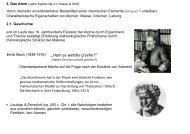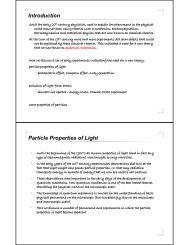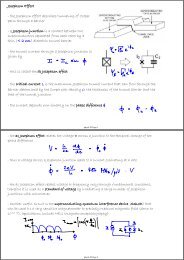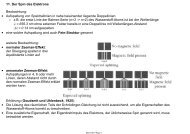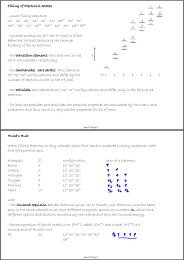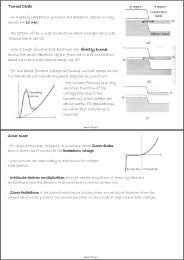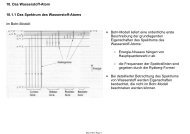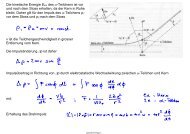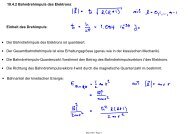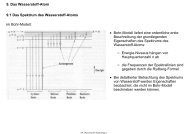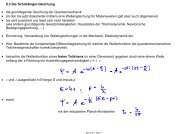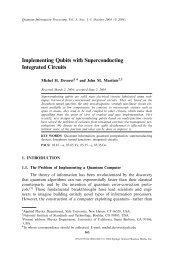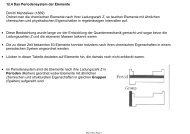slides - ETH Zürich
slides - ETH Zürich
slides - ETH Zürich
You also want an ePaper? Increase the reach of your titles
YUMPU automatically turns print PDFs into web optimized ePapers that Google loves.
Quantum information processing<br />
with trapped ions<br />
Christian Roos<br />
Institut für Quantenoptik und Quanteninformation<br />
Innsbruck, Austria<br />
Lecture program:<br />
• Ion traps, linear ion crystals<br />
• Encoding of qubits in trapped ions<br />
• Initialization, manipulation and detection<br />
• Single qubit and entangling quantum gates<br />
• Some recent experiments<br />
<strong>ETH</strong> <strong>Zürich</strong>, 23.11. 2009
Paul traps: Historical development<br />
Predecessor of the ion trap (1953, Wolfgang Paul and co-workers):<br />
Quadrupole mass filter: Mass-dependent confinement of charged particles in two dimensions.<br />
Mass spectrometry:<br />
Measurement of e/m<br />
Paul trap, „Ionenkäfig“ (1955-1958):<br />
Confinement of particles in a radio-frequency<br />
3D-quadrupole field<br />
Very sensitive mass analyzer
Paul traps: Historical development<br />
z<br />
endcaps<br />
ring<br />
electrode<br />
+/- + +/-<br />
x<br />
y<br />
alternating voltage
Trapped microspheres<br />
trapped ion group, JQI, University of Maryland<br />
http://www.iontrap.umd.edu/research/microspheres/MVI_01731.wmv
Mechanical analogue of the Paul trap<br />
Rotating saddle potential<br />
D. Hucul, trapped ion group, JQI, University of Maryland<br />
http://www.iontrap.umd.edu/research/microspheres/HUCUL!.WMV
Linear ion trap<br />
2d rf-quadrupole + static potential PRL 68, 2007 (1992), PRA 45, 6493 (1992)<br />
y<br />
0V RF U end U end<br />
z 0<br />
x<br />
RF<br />
0V<br />
Li i t<br />
Linear ion trap,<br />
Innsbruck 2009
Microfabricated segmented linear traps
Microfabricated segmented linear traps<br />
~ 50 µm<br />
Au on sapphire<br />
2 mm<br />
fabricated at<br />
fabricated at<br />
<strong>ETH</strong> <strong>Zürich</strong>
Quantum physics with trapped ions: the experimental tools<br />
Ion trap<br />
Lasers<br />
Trapped ions<br />
Detector
How to trap single ions<br />
atomic<br />
beam<br />
oven
windows<br />
How to trap single ions<br />
atomic<br />
beam<br />
vacuum<br />
pump<br />
oven
How to trap single ions<br />
fluorescence<br />
detection with<br />
CCD-camera<br />
CCD<br />
camera<br />
atomic<br />
beam<br />
photomultiplier<br />
oven<br />
Laser beams for:<br />
photoionisation<br />
laser cooling<br />
quantum state manipulation<br />
fluorescence detection<br />
Vacuum<br />
pump
The real picture
Quantum physics with trapped ions<br />
„…we never experiment with just one electron or atom or<br />
(small) molecule. In thought-experiments we sometimes assume<br />
that we do; this invariably entails ridiculous consequences.“<br />
Erwin Schrödinger , 1952
Quantum aspects of trapped ion experiments<br />
A single trapped ion: Realization of a quantum harmonic oscillator<br />
Motional degrees of freedom<br />
A single trapped ion: Realization of a quantum bit<br />
Internal degrees of freedom
Quantum information processing with trapped ions<br />
Strings of trapped ions: Each ion encodes a qubit<br />
Coupling of internal states via motional degrees of freedom<br />
Effective spin-spin i interaction<br />
ti<br />
G ti f t l d t t<br />
• Generation of entangled states<br />
• Realization of quantum gates
Ion strings: Collective modes of motion<br />
Electronic excitation of motional modes + stroboscopic illumination:<br />
„center-of-mass mode“<br />
„stretch mode“
Appropriate atomic ion systems<br />
pp p y<br />
for quantum information processing
Trapped ion quantum bits<br />
Ions with optical transition to metastable level: 40 Ca + , 88 Sr + , 172 Yb +<br />
P 1/2 metastable<br />
D t „optical qubit“<br />
5/2<br />
|e><br />
τ =1s<br />
detection Doppler<br />
optical<br />
qubit manipulation requires<br />
cooling<br />
Sideband<br />
d<br />
transition<br />
ultrastable laser<br />
cooling<br />
S 1/2<br />
40<br />
Ca +<br />
S 1/2<br />
|g><br />
stable<br />
Ions with hyperfine structure: 9 Be + , 43 Ca + , 111 Cd + ,<br />
171 Yb + …<br />
„hyperfine qubit“<br />
detection<br />
|e><br />
|g><br />
hyperfine<br />
ground states<br />
qubit manipulation with<br />
microwaves or lasers
Experimental sequence<br />
P 1/2 D 5/2<br />
1. Initialization in a pure quantum state<br />
P 1/2 D 5/2<br />
2. Quantum state manipulation on<br />
Quantum state t =1s<br />
manipulation Fluorescence<br />
detection<br />
S 1/2<br />
40<br />
Ca +<br />
S 1/2<br />
S 1/2 – D 5/2 transition<br />
1/2 5/2<br />
3. Quantum state measurement<br />
by fluorescence detection<br />
Two ions:<br />
5µm<br />
Spatially resolved<br />
detection with<br />
CCD camera:<br />
50 experiments / s<br />
Repeat experiments<br />
100-200 times
Quantum state detection<br />
P 1/2<br />
Quantum bit<br />
Photon count histogram<br />
Measurement of σ z
Trapped-ion laser interactions<br />
Carrier resonance<br />
…
Coherent excitation: Rabi oscillations<br />
„Carrier“ pulses:<br />
Bloch sphere<br />
representation<br />
D state population
Trapped-ion laser interactions<br />
Red sideband<br />
…<br />
Jaynes-Cummings model
Trapped-ion laser interactions<br />
Blue sideband<br />
…<br />
Anti-Jaynes Cummings model
Carrier and sidebands: excitation spectrum (3 ions)<br />
(red / lower)<br />
motional sidebands<br />
carrier transition<br />
(blue / upper)<br />
motional sidebands<br />
Laser detuning Δ at 729 nm (MHz)
Coherent excitation on the sideband<br />
„Blue sideband“ pulses:<br />
…<br />
Entanglement between een internal and motional state !<br />
D state population<br />
p
Entangling quantum gate operations<br />
• Cirac-Zoller CNOT gate<br />
• Mølmer-Sørensen gate<br />
• Conditional phase gate
Entangling two qubits<br />
First strategy:<br />
A focussed laser interacts with a single qubit<br />
at atime<br />
time.<br />
• Cirac-Zoller controlled-NOT gate
Entangling two qubits<br />
First strategy:<br />
A focussed laser interacts with a single qubit<br />
at atime<br />
time.<br />
• Cirac-Zoller controlled-NOT gate<br />
Second strategy:<br />
A laser interacts t with a several qubits<br />
at the same time.<br />
• Mølmer-Sørensen gate<br />
• controlled-phase gate
Mølmer-Sørensen gates<br />
How does it work ?<br />
Bell states: creation and verification<br />
GHZ states
Mølmer-Sørensen gate<br />
Two ions<br />
n+1<br />
n<br />
n-1<br />
Bichromatic lasers:<br />
n+1 n+1<br />
n<br />
n-1<br />
n<br />
n-1<br />
After time<br />
n+1<br />
n<br />
n-1<br />
Maximally entangling gate<br />
A. Sørensen, K. Mølmer, Phys. Rev. A 62, 022311 (2000)
Mølmer-Sørensen gate: time evolution<br />
p SS +p DD = 0.9965(4) 13,000 measurements
Entanglement check : interference<br />
constructive<br />
interference<br />
π/2<br />
π/2<br />
π/2<br />
π/2
Entanglement check : interference<br />
constructive<br />
interference<br />
Parity<br />
π/2<br />
π/2<br />
destructive<br />
interference<br />
- 1<br />
+ 1<br />
π/2<br />
π/2<br />
Final state t dependsd on phase of π/2 pulse<br />
Coherence measurement:<br />
Scan φ and measure parity
Mølmer-Sørensen gate: parity oscillations<br />
A = 0.990(1) 29,400 measurements<br />
p SS +p DD = 0.9965(4) 13,000 measurements<br />
Bell state fidelity<br />
F=99.3(1)%
Creating Bell states<br />
Fidelity<br />
F=99.3(1)%<br />
J. Benhelm et al., Nat. Phys. 4, 463 (2008)
‘Hot’ Bell states<br />
Fidelity<br />
F ≈ 98%<br />
Doppler-cooled l ions !<br />
G. Kirchmair et al., New J. Phys 11, 023002 (2009)
Creating GHZ-states with 4 ions<br />
DDDD<br />
DDDS<br />
DDSD<br />
DSDD<br />
SDDD<br />
DDSS<br />
DSDS<br />
DSSD<br />
SDDS<br />
SDSD<br />
SSDD<br />
n = 1<br />
n = 0<br />
DSSS<br />
SDSS<br />
SSDS<br />
SSSD<br />
|0,SSSS>
Creating GHZ-states with 6 ions<br />
DDDDDD<br />
DDDDSS<br />
…<br />
DDDDSS<br />
…<br />
DDDSSS<br />
…<br />
DDSSSS<br />
…<br />
DSSSSS<br />
…<br />
SSSSSS
Creating GHZ-states with 8 ions<br />
DDDDDDDD<br />
SSSSSSSS
N - qubit GHZ state generation<br />
Fidelity (%)<br />
Parity signal<br />
1 single ion Ramsey fringe<br />
99.5(7)<br />
2<br />
3<br />
99.6(1.6)<br />
98.7(2.0)<br />
4<br />
95.8(1.5)<br />
5)<br />
6<br />
91.9(3.0) 9(3 8<br />
82.1(2.8)<br />
T. Monz, P. Schindler, J. Barreiro, M. Hennrich, Innsbruck (2009)
Further literature<br />
Review articles:<br />
D. Leibfried et al.‚Quantum dynamics of single trapped ions‘<br />
,<br />
Rev. Mod. Phys. 75, 281 (2003)<br />
H. Häffner et al.‚Quantum computing with trapped ions‘<br />
,<br />
Phys. Rep. 469, 155 (2008)<br />
R Blatt D Wineland Entangled states of trapped atomic ions‘<br />
R. Blatt, D. Wineland‚ ‚Entangled states of trapped atomic ions ,<br />
Nature 453, 1008 (2008)



